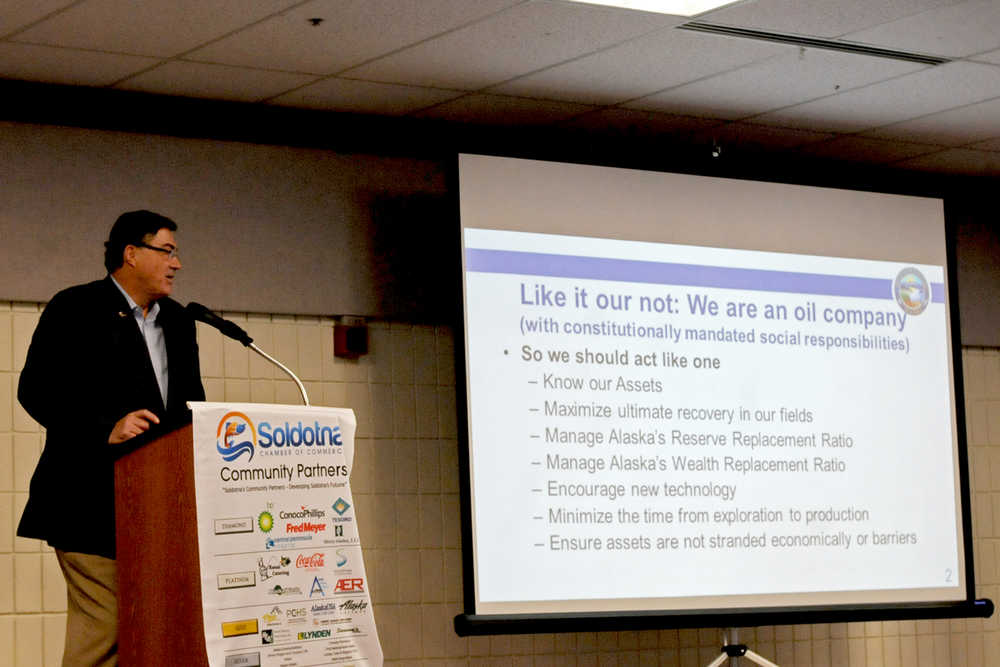Gov. Bill Walker’s lead oil and gas advisor Tuesday emphasized the importance of a fiscal plan to ensure the state’s future.
John Hendrix, the former manager of Apache Corporation’s Alaska operations, has been advising Walker on oil and gas issues since July, particularly on navigating the low-production and low-price environment. During a Tuesday joint Kenai and Soldotna chambers of commerce luncheon, he addressed some of the opportunities and challenges facing the oil and gas industry in Alaska, including the potential Alaska LNG Project.
A repeated message throughout his presentation was the need for a fiscal plan. After the Legislature adjourned in June without adopting a fiscal plan or implementing new sources of revenue to supplement the general fund, the state is drawing down mostly on its savings to fund government. Echoing multiple speeches Walker has given, he called for the Legislature to adopt a fiscal plan and expressed support for the governor’s budget plan that failed to pass last year. The state is burning through approximately $1.2 billion every 100 days in savings, which is not sustainable and needs to change, he said.
“The longer we wait, the more draconian things are going to have to be,” he said. “We don’t want that for our kids, we don’t want that for our businesses, and we don’t want that for our own individual pocketbook.”
Moving forward in oil and gas
development, Hendrix said there needs to be an examination of development planning in the future. Right now, individual companies do planning of their holdings on the North Slope, but there is no overarching management plan for the development of the area. He suggested a plan that determines the overall enviornmental carrying capacity of the oil and gas resources on the North Slope, similar to one the U.S. Army Corps of Engineers uses for wetlands planning.
“People are doing it in pieces, but we don’t do it together,” he said.
In addition to comprehensive planning, a more efficient permitting process is needed among the agencies. He suggested a “one-stop shop” for federal permits to make communication easier and avoid delays. The state should minimize fees and make sure companies understand them, and with the recent election of President-elect Donald Trump, a change in federal administration could mean potentially more opportunity to access federal lands for development, he said.
Not all of his suggestions were on the regulatory side. Oil and gas producers need to achieve better recovery rates on their wells, he said.
“If we’re not maximizing the recovery, and people drill a well and they say 40 percent recovery factor, that means that if there’s a billion barrels they only got 400 million,” he said. “I want them to get to 50, 60 percent recovery factor.”
Oil companies also have to keep up their exploration as they produce to make sure they will still have resources to draw from in the future. If a company produces a million barrels of oil per day, it needs to be finding the same amount to keep up with production in the future, he said.
The state needs to facilitate oil and gas exploration as well to keep production up and the government needs to be pro-industry and have predictable laws, he said.
“We can’t control oil prices, but we can control to some degree … how we attract companies to explore for oil in the soil by our actions and what we say,” he said.
He also addressed the potential Alaska LNG Project, which is currently still in the planning phase before going to a final application to the Federal Energy Regulatory Commission. After the three producer partners, ExxonMobil, ConocoPhillips and BP, announced in August that they would draw back from further investment in the project, the state began to plan to take over the leadership of the project through the state-formed Alaska Gasline Development Corporation. The state can’t afford to fund the project itself, so suggested plans have been to seek third-party investment or issue bonds to fund the project.
The need for a gasline project is still there — producers on the North Slope reinject massive amounts of natural gas every day, but the issue is whether the market will sustain the cost of the project. Hendrix said the state can’t “go it alone” and will need buy-in from the oil and gas companies, which are also going through budget cuts in the low oil price environment. The state also needs to find the market for the gas once the pipeline is built, he said.
“The state leading the project right now is probably a pretty good turn for us,” he said. “We’re not going to go ahead unless we can sell our gas. The problem is we have to have both the project and the gas.”
Kenai Peninsula Borough Mayor Mike Navarre’s special assistant on oil and gas, Larry Persily, also spoke at the luncheon to provide updates on the state’s transition to lead the LNG project. There are still a number of transition issues to work out, such as the state obtaining control of the land purchased for the proposed plan in Nikiski and getting the LNG export license transferred to state ownership.
The state is hoping to get a tax exemption on bonds issued to fund the project, which would help bring down the cost, and seeking funds from third-party investors that may not expect as high a rate of return as another oil and gas company. In the end, someone is going to have to bear the financial risk for the project, though.
“Someone has to take the risk that it costs X dollars in 2027 to produce LNG and to deliver it, and maybe the market price just isn’t that high,” Persily said.
Reach Elizabeth Earl at elizabeth.earl@peninsulaclarion.com.

